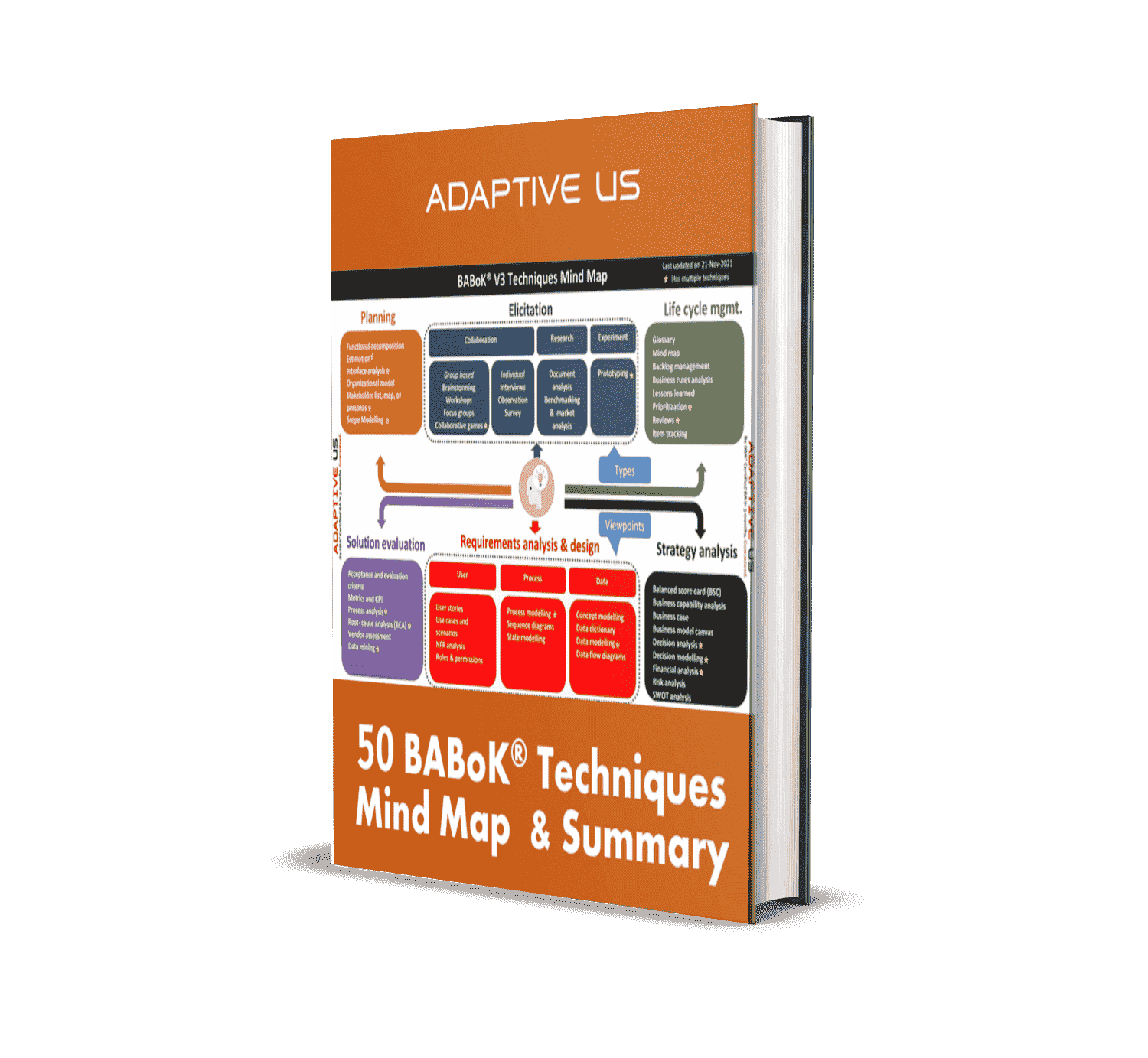Guide to Affinity Diagram as a Business Analyst Technique
What is an Affinity Diagram?
An affinity diagram is a powerful business analysis technique that helps identify trends, issues, and potential solutions by organizing large amounts of unstructured data into meaningful clusters. It is also known as an affinity map or KJ Method, named after its creator, Kawakita Jiro.
Creating an affinity diagram involves gathering data or ideas from various sources, such as brainstorming sessions, interviews, surveys, etc. These ideas are usually written on Post-it notes or index cards and then grouped based on their natural relationships or similarities. This grouping exercise allows for identifying themes and patterns within the data.
The resulting visual representation in an affinity diagram enables teams to see connections between seemingly unrelated ideas, leading to better understanding and decision-making. It also helps prioritize critical issues or areas to focus on based on their importance and impact.
History of the Affinity Diagram
Using affinity diagrams as a business analyst technique was introduced in the 1960s by Japanese ethnographer Jiro Kawakita. He used this method to categorize large amounts of qualitative data and create meaningful groupings, which could be used for further analysis. The term "affinity diagram" was coined by his colleague Goichi Nakagawa, who believed that sorting and organizing ideas based on natural relationships between them resembled the bonds of affinity.
Affinity diagrams gained popularity in the 1970s when American management consultant Tomoyuki Yuzawa included them in his book "Quality Improvement through Competitive Value Analysis." In this book, he described how affinity diagrams were used to identify customer needs and expectations and translate them into specific product features.
In the 1980s, affinity diagrams spread to other industries, such as software development, marketing, and problem-solving processes. During this time, businesses realized this technique's potential in understanding complex problems and finding efficient solutions.
Since then, affinity diagrams have become essential for business analysts in various industries. During brainstorming sessions or workshops, they help gather insights from stakeholders and team members. The visual nature of an affinity diagram makes it easier to see patterns and connections between seemingly unrelated ideas, leading to better-informed decisions.
When is the Affinity Diagram used?
- Brainstorming sessions:
The affinity diagram is commonly used during brainstorming sessions to organize ideas and concepts into logical groups. It enables participants to generate ideas freely while organizing them into relevant categories for further analysis. This helps in streamlining discussions and avoiding confusion or duplication of ideas.
- Root cause analysis:
When faced with complex problems or issues within a project, a business analyst can use an affinity diagram to identify root causes. By breaking down the problem into smaller components and organizing them based on similarities or relationships, the key factors contributing to the issue can be identified more clearly.
- User research findings:
Businesses often gather large amounts of qualitative data from their target audience during user research, such as interviews, surveys, or usability tests. This data needs systematic organization before it can be analyzed effectively. An affinity diagram provides a structure for organizing insights from these research activities into themes or categories, making it easier for analysts to make sense of them.
- Requirements gathering workshops:
In agile project management methodologies like Scrum, collaborative requirements-gathering workshops are crucial for eliciting and prioritizing user needs and features. The affinity diagram is an excellent tool for sorting quickly and efficiently through various requirements generated during these meetings.
- Data analysis:
Large datasets gathered from different sources may contain unstructured information that requires efficient organization before any analysis can begin. Affinity diagrams provide a visual representation of patterns within the data that might not have been evident otherwise.
Steps to Create an Affinity Diagram
Creating an affinity diagram is helpful for business analysts to organize and categorize large amounts of data. It allows teams to make sense of complex and diverse information, identify patterns, and generate new insights. Here are the steps to follow in creating an affinity diagram:
- Gather Data: The first step is to gather all the relevant data that needs to be organized. This can include interview or survey responses, meeting notes, research findings, user feedback, or any other sources of information.
- Define Categories: Once you have collected all the data, start by defining broad categories based on common themes or characteristics found within the data. These categories will serve as the main headings for your affinity diagram.
- Write down Ideas: Next, write each idea or information on sticky notes or cards. Use one idea per note/card to keep them manageable and easy to move around during the organization process.
- Group Similar Ideas: Begin grouping similar ideas under each category by placing them next to each other on a blank canvas (e.g., whiteboard or table). As you group ideas, consider their relationships and connections with different ideas.
- Identify Patterns: Look for patterns emerging within each group, such as recurring themes or common issues being raised by stakeholders.
- Refine & Rearrange: Continuously refine and rearrange your groups until all ideas have been allocated into their appropriate categories and subgroups within those categories are also formed.
- Label Categories: Once all ideas have been categorized, label your groups with descriptive headings based on what they represent.
- Discuss & Collaborate: At this point, it may be helpful to discuss the results with team members and seek their input in refining the organization of ideas further.
- Analyze Results & Draw Conclusions: With all ideas organized into meaningful groups, analyze the results to conclude trends, information gaps, and potential opportunities for improvement or further investigation.
- Document & Communicate Results: Take a picture or create a digital copy of your affinity diagram for documentation purposes and to communicate the results to stakeholders. You can also use the diagram as a visual aid during presentations or discussions.
What should be the results of an Affinity Diagram
1) Categorized and Organized Information:
The primary result of an Affinity Diagram is that it categorizes and organizes information into logical groups based on their similarities. This helps to make sense of complex and unstructured data, making it easier to analyze and understand.
2) Identification of Key Themes:
By grouping similar ideas, an Affinity Diagram highlights common themes or patterns within the data. This allows business analysts to identify key themes that emerge from the information, providing valuable insights for decision-making.
3) Clarification of Ideas:
As different stakeholders are involved in providing input for an Affinity Diagram, it can help to clarify any misunderstandings or confusion about specific ideas or concepts. A shared understanding is achieved through group discussions and collaboration, leading to better alignment among team members.
4) Prioritization of Ideas:
While creating an Affinity Diagram, participants are encouraged to vote on which groups they believe are most important or relevant. This prioritization helps focus on critical areas and identify critical issues needing immediate attention.
5) Visualization for Decision Making:
The visual representation provided by an Affinity Diagram makes it easier for stakeholders to see the bigger picture and make informed decisions based on evidence rather than opinions. The diagram serves as a reference point throughout the decision-making process.
6) Identification of Gaps:
While working with large amounts of data, gaps may emerge, indicating missing pieces or incomplete information. An Affinity Diagram can help identify these gaps so they can be addressed and filled through further research.
7) A Holistic View:
One of the main benefits of an Affinity Diagram is that it provides a holistic view of the data or ideas being analyzed. By grouping and connecting different concepts, patterns, and themes, stakeholders comprehensively understand the problem.
Advantages of Affinity Diagrams
- Encourages Group Participation:
The most significant advantage of affinity diagrams is that they encourage every team member to actively participate in generating ideas and organizing them into logical groups. It eliminates the risk of dominant individuals dominating discussions while ensuring everyone's voice is heard.
- Promotes Clarity and Understanding:
Using an affinity diagram clarifies the complex concepts being discussed as it organizes numerous thoughts into manageable groups with a clear purpose. The visual representation also helps stakeholders better understand patterns, connections, and dependencies between different ideas.
- Organizes Information Effectively:
Traditional brainstorming sessions can result in a large amount of unstructured data that can be challenging to work with effectively later. With an affinity diagram, however, this data gets categorized into meaningful clusters, making it easier for analysts to identify common themes or issues quickly.
- Facilitates Decision Making:
Decision-making can be daunting when dealing with complex problems or tasks involving multiple variables without proper organization tools like an affinity diagram. This method streamlines the thought process by grouping relevant data so that analysts can compare related ideas when making difficult decisions.
- Encourages Creativity:
Affinity diagrams help stimulate creativity within teams as they provide a broader overview of all possible aspects related to solving a problem or achieving desired goals without prioritizing any particular idea over another. This approach allows for out-of-the-box thinking while still maintaining structure through categorization.
- Breaks Down Communication Barriers:
In group settings where opinions may clash, it isn't uncommon for communication barriers to arise. Affinity diagrams prevent this by visualizing the problem, allowing team members to focus on ideas rather than individuals. It ensures that all stakeholders feel heard and valued, leading to better collaboration and teamwork.
Limitations of Affinity Diagrams
- Subjectivity: One of the main limitations of affinity diagrams is their subjectivity. The process involves grouping information based on the analyst's interpretation, which can lead to biased results. Different individuals may have different ways of categorizing information, leading to inconsistencies in the final diagram.
- Limited number of categories: Affinity diagrams typically use Post-it notes or cards to sort and group information. This physical limitation can make it challenging to accommodate a large amount of data as only so much space is available on a flip-chart or board. As a result, the number of categories may be limited, potentially leaving out relevant ideas or concepts.
- Time-consuming: Creating an affinity diagram is a time-consuming process requiring significant effort and resources from the analyst and stakeholders involved in the project. Depending on the amount of data to be analyzed and grouped, it can take several hours or even days to complete.
- Lack of hierarchy: The lack of hierarchical structure in Affinity diagrams is another limitation. The method primarily focuses on grouping related ideas without considering their relationships with one another or their level of importance within the overall concept being studied.
- Training needed for stakeholders: Involving stakeholders in the affinity diagramming process requires them to have previous knowledge about this technique; otherwise, they may not fully understand how it works or how they can contribute effectively.
- Difficulty with virtual collaboration: With remote work becoming increasingly common due to current global circumstances, conducting an affinity diagram exercise virtually presents challenges such as syncing real-time updates and difficulty with physical card sorting if not all participants can access similar tools.
Conclusion
The affinity diagram is a powerful and efficient tool for business analysts to gather and organize large amounts of information into meaningful categories. By following the seven simple steps outlined in this guide, analysts can use this technique to identify patterns, insights, and potential solutions that benefit their organization. So, next time you face a complex problem or need to make sense of overwhelming data, try the affinity diagram and see how it can enhance your analysis process.
You May Also Like
These Related Stories

Concept model vs. Data model | Free BA Techniques eBook

A Functional Decomposition Technique Guide for Business Analyst's


No Comments Yet
Let us know what you think